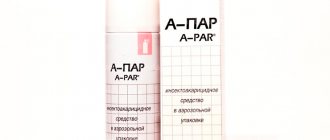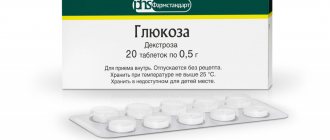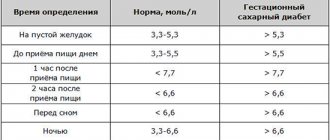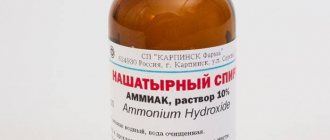Pharmacological properties
The drug has a metabolic and detoxification effect.
Pharmacodynamics
The drug is an isotonic solution of dextrose, which in the body is converted into the form of glucose-6-phosphate. The substance participates in various metabolic processes in the body, accelerates redox reactions, and improves the liver’s ability to fight toxins. The use of the solution helps to increase the osmotic pressure of urine and blood. Dextrose also increases myocardial contractility, enhances diuresis and has a volemic, vasodilating and detoxification effect.
Pharmacokinetics
The absorption rate of dextrose is quite high, and it is completely metabolized in the liver. The substance is not eliminated (its detection in urine is considered a sign of pathology).
special instructions
To improve the absorption of dextrose, used in higher doses, it is recommended to prescribe insulin to the patient at the same time. The drugs are administered in the following proportion - 1 unit of insulin per 4-5 grams of dextrose.
The use of dextrose in combination with other drugs requires monitoring of pharmacological compatibility.
Both five and ten percent solution for infusion can be used according to indications during pregnancy and breastfeeding.
For diabetics, dextrose should be administered under the control of its content in the urine and blood.
There is no data that would indicate a negative effect of the drug on the speed of motor and mental reactions. That is, the solution does not impair a person’s ability to drive a vehicle or perform work that is potentially hazardous to health and life.
Indications for use
- Insufficient carbohydrate nutrition;
- Hypoglycemia;
- Toxic infection;
- Intoxication;
- Dehydration (due to diarrhea, vomiting, in the postoperative period);
- Intoxication due to liver diseases (hepatitis, liver atrophy and dystrophy, including liver failure);
- Collapse;
- Hemorrhagic diathesis;
- Shock.
Dextrose is also used to prepare solutions of drugs for intravenous administration, and is used as a component of various anti-shock and blood-substituting fluids.
Side effects
In general, the drug is well tolerated. Sometimes infusions with dextrose can cause the development of fever, water-salt imbalance (including hyperglycemia, hypervolemia, hypomagnesemia, etc.), acute left ventricular failure.
Symptoms of dextrose overdose are glucosuria, hyperglycemia, and water-electrolyte imbalance. If they develop, the infusion should be stopped and insulin should be administered to the patient. Further treatment is symptomatic.
Contraindications
Absolute:
- Pulmonary edema;
- Overhydration;
- Hyperglycemia;
- Hyperosmolar coma;
- Hyperlactic acidemia;
- Brain swelling;
- Acute left ventricular failure;
- Postoperative disorders of glucose utilization;
- Hypersensitivity to the drug.
Relative:
- Hyponatremia;
- Decompensated heart failure;
- Diabetes;
- Chronic renal failure (oliguria, anuria).
Measuring instruments
It will not be possible to make moonshine at home not only without a moonshine still, but also without the use of measuring instruments that provide control of the important parameters of the drink being prepared and the entire process as a whole.
Thermometer
All stages of moonshine brewing require a thermometer. First, when breeding yeast. Basically, the manufacturer indicates what temperature the water should be to activate the stamp
It is important to consider the temperature of the remaining ingredients. Next, install the mash, and you definitely can’t do without a thermometer
Chemical reactions take place in the fermentation tank. Yeast, which must be included, is a living organism that requires a certain temperature to function, depending on the strain and volume of sugar. There is a range of values at which the fermentation process proceeds properly. If the recommended temperatures decrease or increase, the process may stop.
Also, the need for a thermometer is associated with dangerous pH-meter vapors formed in the middle of heating during distillation. The measuring device will help monitor the temperature during the distillation of the wort and determine the moment when harmful impurities disappear.
The resulting liquid when the thermometer readings are 60-65 degrees is not suitable for consumption and must be disposed of. A high-quality drink is obtained at temperatures of 72-78 degrees. In this range, the heated mash is processed into ethyl alcohol
It is important not to allow the temperature to rise above 85 degrees, in order to avoid the release of fusel oils, which will negatively affect the smell and taste of alcohol, and also cause a severe hangover or human poisoning
Refractometer
An optical instrument for determining the concentration of solutions is a refractometer. It can be used to find out the level of sugar and alcohol in a liquid. The device will also help determine the completion of the fermentation process. If its scale reaches 0, then the mash should be removed.
They can be digital or manual. The latter type is used by experienced moonshiners.
pH meter
Yeasts are organisms that actively work under certain conditions. In addition to temperature, they are affected by acidity, an indicator that determines the timing of fermentation, and therefore the taste of moonshine. Why do you need a pH meter? The device allows you to determine the level of acidity. Its feature is automatic temperature compensation, which allows measurements in the temperature range from 0 to 50°C without loss of measurement accuracy. The main advantages: ease of operation and high accuracy of the device.
Alcohol meter
In order for the drink to please you with its quality, you must not only strictly follow the technological process and have an alcohol meter, which will allow you to measure the volume fraction of alcohol in the solution, i.e. determine the strength of the raw alcohol and the finished product.
The operating principle of the device is based on density indicators. When the speedometer is immersed in liquid, part of it is pushed out by a weight and reaches a division corresponding to the percentage of alcohol contained in the drink.
What types of alcohol meters are there:
- Laboratory. It is popular among home distillers because it provides absolute accuracy.
- Domestic. It is used in everyday life to measure the percentage of alcohol in aqueous solutions.
- Digital. A quick response device that additionally detects temperature. It is used for measurements in the cooler of a working apparatus during the distillation process.
- Optic. The device is capable of operating in a wide range of temperatures, in different solutions containing alcohol, from water-alcohol to multicomponent. The principle of its operation is a computer analysis of the light absorption spectrum of a liquid.
Instructions for use of Dextrose: method and dosage
According to the instructions, Dextrose is intended for intravenous administration, drip or jet.
A 5% solution is administered dropwise at a rate of no more than 7 ml/minute (400 ml per hour) in a daily dose for adults of up to 2000 ml; 10% solution - at a rate of no more than 3 ml/minute in a daily dose for adults up to 1000 ml.
10-50 ml of a 10% solution are prescribed in a stream.
When prescribing parenteral nutrition to adult patients with normal metabolism, the maximum permissible daily dose of Dextrose is no more than 4-6 g/kg (i.e. approximately 250-450 g/day), the drug is administered at a rate of 0.25-0.5 g /kg/hour. If the metabolic rate decreases, the dose is reduced to 200-300 g and administered at a rate of 0.125-0.25 g/kg/hour. The daily volume of fluid administered should be 30-40 ml/kg.
Dextrose is administered to children as parenteral nutrition (along with fats and amino acids): on the first day - 6 g/kg/day, then up to 15 g/kg/day. When calculating the dose of the drug when administering 5% and 10% solutions, it is necessary to take into account the permissible daily volume of administered fluid: children weighing 2-10 kg - 100-165 ml/kg, children weighing 10-40 kg - 45-100 ml/kg . The maximum permissible rate of administration is 0.75 g/kg/hour.
Composition, release form and analogues
The drug Dextrose is produced in the form of a 5% and 10% solution for infusion in bottles or vials of 100 ml.
Analogs of Dextrose in terms of the active substance are the medications Glucose and Glucosteril. In some cases, one of the drug analogues that has a similar therapeutic effect is prescribed: Infuzolipol, Aminoven, Hymix, Aminosol-Neo, Aminocrovin, Dipeptiven, Hydramin, Infusamine, Kabiven, Aminotrof, Lipofundin, Nephrotect, SMOFlipid, Omegaven, Polyamine, Fibrinosol, Oliclinomel.
How to get glucose?
Glucose is quite easy to obtain at home. To do this, you need to take starch paste and mix it with ten percent sulfuric acid. For a glass of paste you will need no more than two teaspoons of acid. The resulting solution should be placed on low heat and stirred constantly. About 15 minutes after the start of heating, you need to take a couple of drops of the solution for testing and drop diluted iodine on them. If blue or red coloration occurs, heating must be continued.
If the color has not changed, then the first stage is over. You need to add 10-15 grams of powdered chalk to the solution to neutralize the acidic environment. The resulting liquid must be put on fire so that about two-thirds of the water evaporates from it. The remaining solution must be filtered through several layers of gauze, and then continue evaporation until a caramel-like mass is formed.
The resulting substance will be glucose. Buying dextrose on an industrial scale is also not difficult. On the Internet you can find a large number of offers from manufacturing companies or their official representatives. The average price is 70 thousand rubles per ton, but with large wholesale purchases you can find a better offer.
Learn more about dextrose at the exhibition
Like most modern developments, the possibility of using dextrose in this and other areas of human life is constantly being studied: it’s just difficult to follow all the news.
But the way out is simply to periodically visit specialized exhibitions, one way or another related to the food industry. For example, the exhibition of equipment for the food industry "Agroprodmash"
.
Fairgrounds Expocentre very often organizes such exhibitions in its pavilions - to visit you just need to come there at the specified time. The forum can tell you about several ways to reduce dextrose consumption, and modern equipment will allow you to automate any process of adding it to the final product.
What equipment should be needed for the production of Parmesan cheeseWhat equipment is needed for fresh juicesLabelling of plastic for food products
Where exactly is dextrose used?
Dextrose in the food industry
used in the following areas:
Production of non-standard nutrition (sports, dietary and medicinal) and various biological additives. Production of confectionery products. Bars and candies to which glucose has been added have a richer taste and color of the filling, in addition, they retain softness longer. Many soft drinks contain glucose, which to a certain extent modifies the taste to what we are used to.
It is important to understand that she does not change him in any way or “kill him” - on the contrary, she supports him, showing the most subtle notes. There is even glucose in canned food - however, it does not add taste to them, but simply preserves the natural color, which looks much more pleasant. Bakery products also contain glucose, which is added during the fermentation of sugar. The taste and aroma of bread, as well as the certain color of the crust, are all due to glucose. Dextrose is also included in dairy products, although only in sweet forms, for example, in yoghurts. Sugar in ice cream is also often replaced with dexrose (this helps save up to 30% of sugar in production)
This is important: Dextrose lowers the freezing point of ice cream, giving it a more palatable texture. Important: you cannot replace all sucrose with dextrose, since such ice cream will melt too quickly and will not taste as pleasant.
As you can see, dextrose is needed by almost every entrepreneur who has decided to open his own business in the food industry. Of course, this does not mean that you need to sprinkle glucose everywhere: just consult with a knowledgeable person so that he can approximately tell you the amount of necessary raw materials and give him some freedom of action. This will be much better: you will be able to devote time to organizing production, while a specialist will add dextrose and other substances.
Features of the temperature regime for fermentation of mash
To make good moonshine, it is recommended to monitor not only the amount of ingredients, but also observe the temperature regime.
To obtain mash you must adhere to the following rules:
Yeast preparation. In order for the fermentation process to proceed normally, it is necessary to dilute the yeast in advance, observing the recommended dosage. To do this, take 500 ml of water at a temperature of 25-30 degrees. Fermentation. After adding yeast to the mash, you need to leave it to ferment in a dark room with a temperature of 20-25 degrees
It is important to prevent this indicator from rising above 30 and falling below +18 degrees, since the yeast will die and fermentation will stop. Therefore, care should be taken to ensure that there are no sudden changes
To do this, install a thermometer near the container in order to promptly lower or increase the temperature to the optimal level.
Specialized drugs for diabetics
A drug that helps lower blood sugar but does not cause hypoglycemia
Glucose has one big disadvantage - by solving the problem of hypoglycemia, a person can provoke hyperglycemia. The sugar level rises again to such an extent that another reduction in sugar is required. To do this, it is recommended to use glucophage and diabetes pills together with insulin.
This is a hypoglycemic drug that has some features that distinguish it from other drugs for lowering sugar:
- reduces sugar levels, eliminating hyperglycemia without causing hypoglycemia;
- unlike other classical means for reducing sugar, it does not provoke excessive production of insulin by the pancreas;
- reduces the state of insulin resistance by increasing the sensitivity of target cells - muscle, fat cells and liver cells to insulin, so that glucose from the blood is utilized along with insulin naturally, without requiring the use of additional medications;
- reduces the rate of absorption of glucose from the intestine into the bloodstream, as a result there is no sharp increase in glucose after eating;
- increases the transport capacity of cell membranes for the passage of glucose;
- helps to break down fats, the metabolism of which is significantly reduced during resistance, so a person’s fight against excess weight is more successful;
- successful utilization helps solve the problem of high bad cholesterol.
Important: reducing insulin resistance is especially important for patients with diabetes who have gained weight; if you take glucophage correctly, you can temporarily stop using glucose in tablets - you won’t need it.










